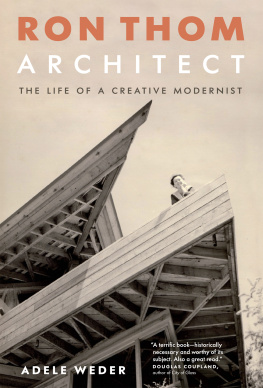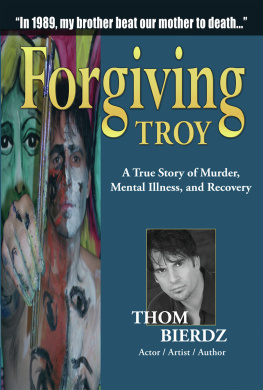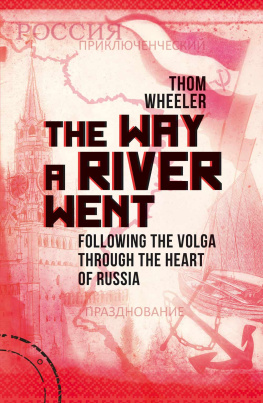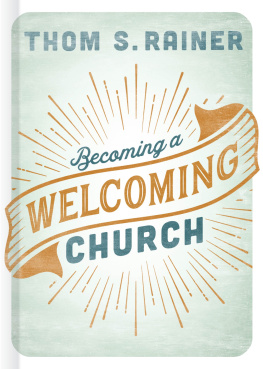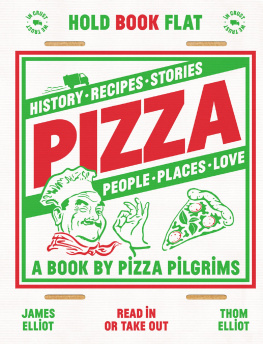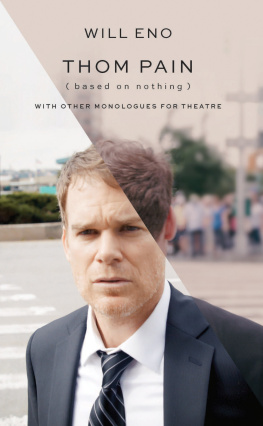Page List


Copyright 2022 by Adele Weder
22 23 24 25 26 5 4 3 2 1
All rights reserved. No part of this book may be reproduced, stored in a retrieval system or transmitted, in any form or by any means, without the prior written consent of the publisher or a licence from The Canadian Copyright Licensing Agency (Access Copyright). For a copyright licence, visit accesscopyright.ca or call toll free to 1-800-893-5777.
Greystone Books Ltd.
greystonebooks.com
Cataloguing data available from Library and Archives Canada
ISBN 978-1-77164-322-1 (cloth)
ISBN 978-1-77164-323-8 (epub)
Editing by Derek Fairbridge
Copy editing by James Penco
Proofreading by Jennifer Stewart
Jacket and interior design by Jessica Sullivan
Front jacket photograph of the Case House, West Vancouver. Courtesy of Anne Ferries, photographer unknown.
Back jacket image of the Case House, West Vancouver, main floor plan. Design by Ron Thom; drawing by Paul Merrick. Courtesy of the West Vancouver Art Museum. Interior photographs as credited
Front Endsheets: Ondaatje Hall, Massey College, Toronto. Photo by Steven Evans. Front door (detail), Carmichael House, West Vancouver. Photo by Josh Nychuk. Back Endsheets: Window with tinted egg-crate flats, Dodek House, Vancouver. Photo by Carla Dodek. Champlain College dining hall ceiling, Trent University, Peterborough. Photo by Alexi Hobbs.
Every attempt has been made to trace ownership of copyrighted material. Information that will allow the publisher to rectify any credit or reference is welcome.
Greystone Books thanks the Canada Council for the Arts, the British Columbia Arts Council, the Province of British Columbia through the Book Publishing Tax Credit, and the Government of Canada for supporting our publishing activities.

is there a rhythm drumming from vision?
shall we tower into art or ashes?
it is our dreams will decide
& we are their Shapers
EARLE BIRNEY,from the shapers: Vancouver, 1958
Contents
Authors Note
WHEN I FIRST STARTED researching this biography over a decade ago, I had yet to recognize the difficulty and complexity of the subject matter. As an artist and architect, Ron Thom worked intuitively, expressing his thoughts in images and gestures more often than in words, which has made his own beliefs and design approach hard to pin down. I never had the opportunity to meet him in person, and the number of surviving friends, colleagues, clients, and other witnesses had already dwindled by the turn of the millennium.
Yet so many people across the country had known him, worked with him, and been deeply touched by him that more than a hundred key witnesses were still alive and lucid. I tracked down his surviving family members, close friends, and significant colleagues; most stood ready to share what they knew of this unique human being. Their recollections were recorded and transcribed, and offered a wealth of insightful thoughts and revelations. As I cross-referenced these interviews with architectural pilgrimages, historic texts, and archival research, a rough picture of his inner creative life slowly emerged.
This methodology involved two major challenges. The first is the passage of time. As his dear friend Molly Bobak told me, Memories dont fade, but they alter. Confirmation of some events and comments required follow-up interviews, phone calls, and emails to double-check certain details, cross-check with historic documents, and compare one individuals memories with anothers. With an eye to improving accuracy, I have sent pertinent manuscript excerpts to Bill Lett, Paul Merrick, Murray Beynon, Denis Smith, and Sherry McKay. When Ive quoted individuals, Ive sent them the specific sentence or paragraph to check. Three individuals who knew Ron Thom for most of his adult lifeMorton Dodek, Barry Downs, and Dick Sai-Chewsaw late-stage drafts of the entire manuscript and provided me with feedback on context, facts, and tone.
Citations from speeches, letters, and other text documents are quoted verbatim. Comments by Ron Thom and other individuals that have been recalled by second parties are in most cases paraphrased, but a small number are in quotations if they are remembered with clarion certainty, if they align with incontrovertible facts from primary sources, and if they are in keeping with the character of the person and the context of the times. When the memory has been hazy, I have paraphrased or omitted the recollection entirely.
In a few cases, the quotations from interview subjects may seem jarring to our contemporary ears. The twentieth-century vernacular included derisive ways to describe people of short height, men of refined grooming, and male-female relationships. That languagealong with the gender-specific word draftsman and the general marginalization of women, Indigenous people, and minoritiesreflects the irreverence and non-inclusivity of an era. By the time the architectural profession welcomed a critical mass of female designers into its fold, the computer had already taken over the draftsmans work and the term became anachronistic. This is a book about how things were, not how they should have been; the quotations relay how people spoke, not how they should have spoken.
Family members have previewed the most sensitive and detailed passages that pertain to their own individual memories of a husband and father. Rons first and second wives and all six of his children generously offered access to a great volume of photographs and letters, as well as their own recollections. From this well of deeply personal information, I have chosen to cite certain anecdotes and comments that help illuminate an aspect of the character, talent, demons, and humanity that also informed his career and his architecture. Therein lies the value of reading about the lives of artists and architects: the life beyond the workplace can help us understand the work.
That brings us to the second major challenge to writing a biography of Ron Thom: how to deal with the issue of the alcohol dependence that dogged him and ultimately destroyed him. We do his memory no favours by ignoring its pernicious effects on his life and career. For many years recognized as one of the greatest architects in Canada, he seemed destined to progress into one of the greatest in North America, until his addiction tightened into a stranglehold. In the words of Trent University founder Tom Symons, That was a great loss to the nation. And though some may find the details of his final days disturbing and gratuitous, Ive included them to dismantle the even more disturbingand falserumours that festered after his death.
But human beings are more than the sum of their demons. Typical of his closest friends, Molly and Bruno Bobak remembered him not only as tormented, hotheaded, and self-destructive but also as brilliant, gifted, funny, generous, magnetic, loveable, and unforgettable. In 2011, as I wrapped up my two-day series of interviews in Fredericton with this nonagenarian couple, I told them that I would do my best to check back with them about any quotes or comments that might end up in this book. Molly replied with cheerful nonchalance, Oh, we dont care what you write. By the time you finish your book, well both be dead!

